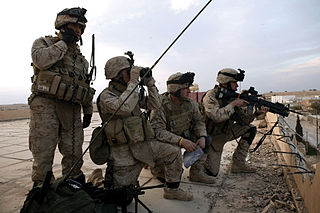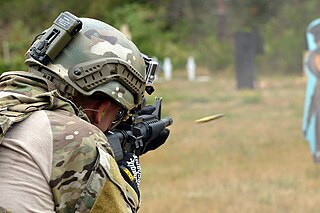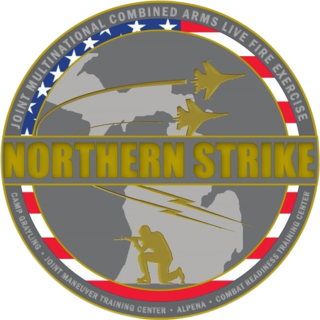
Forward air control is the provision of guidance to close air support (CAS) aircraft intended to ensure that their attack hits the intended target and does not injure friendly troops. This task is carried out by a forward air controller (FAC).

A tactical air control party, commonly abbreviated TACP, is a small team of military personnel who provide coordination between aircraft and ground forces when providing close air support.

Air Naval Gunfire Liaison Company (ANGLICO) is an airborne fire support and liaison unit of the United States Marine Corps. The mission of ANGLICO is "To provide Marine Air-Ground Task Force (MAGTF) Commanders a liaison capability to plan, coordinate, and conduct terminal control of fires in support of joint, allied, and coalition forces. Per this mission statement, ANGLICOs are not designed to support U.S. Marine Corps maneuver elements. Instead, the doctrinal purpose of ANGLICO is to provide fire support and coordination in support of units adjacent to the MAGTF.

No. 4 Squadron is a Royal Australian Air Force squadron composed of the air force special forces Combat Controllers, aircrew who operate the Pilatus PC-21 aircraft and instructors for the Australian Defence Force Joint Terminal Attack Controller (JTAC) course.

The USAF Weapons School is a unit of the United States Air Force and United States Space Force, assigned to the 57th Wing and Space Delta 1. It is located at Nellis AFB, Nevada.

The 6147th Tactical Control Group was a United States Air Force unit that fought in the Korean War. The unit was attached to Far East Air Forces Fifth Air Force

The 178th Wing is a unit of the Ohio Air National Guard, stationed at the Springfield-Beckley Municipal Airport ANG complex, Springfield, Ohio. If activated to federal service, the wing is gained by the United States Air Force (USAF) Air Combat Command (ACC), with elements of the wing gained by the Air Force Intelligence, Surveillance and Reconnaissance Agency (AFISRA).

The United States Air Force Combat Control Teams, singular Combat Controller (CCT), are an elite special operations force who specialize in all aspects of air-ground communication, as well as air traffic control, fire support, and command, control, and communications in covert, forward, or austere environments.

The 549th Combat Training Squadron is a non-flying United States Air Force unit. It is assigned to the 57th Operations Group, and is stationed at Nellis Air Force Base, Nevada. It conducts air support and air interdiction sorties in "Green Flag (West)" exercises to train USAF fighter pilots and the aerospace power component to the US Army's brigade combat training.

The 3rd Air Support Operations Squadron is a combat support unit of the United States Air Force, located at Fort Wainwright, Alaska.
Air Support Operations Center (ASOC) is a USDoD term for a subsection of a Theater Air Control System (TACS) located near a corps headquarters or some other land force headquarters, which directs and oversees close air support and similar sorts of tactical air support.

A United States Air Force Tactical Air Control Party, commonly abbreviated TACP, is an individual or team of United States Air Force Special Warfare Airmen with AFSC 1Z3X1, who are aligned with conventional, Special Operation Forces, and Tier 1 combat maneuver units. They provide precision terminal attack control and terminal attack guidance of U.S. and coalition fixed- and rotary-wing close air support aircraft, artillery, and naval gunfire; establish and maintain command and control (C2) communications; and advise ground commanders on the best use of air power.
Forward observers in the U.S. military are artillery observers who carry the Military Occupational Specialty designator of 13F in the United States Army and 0861 in the United States Marine Corps. They are officially called "joint fire support specialists" in the U.S. Army and "fire support marines" in the U.S. Marine Corps. They are colloquially known as "FiSTers", regardless of whether they are members of a FiST. A battalion fire support officer (FSO) is the officer in charge of a battalion fire support element.

Draken International, LLC is an American provider of tactical fighter aircraft for contract air services including military and defense industry customers. The firm is based at the Lakeland Linder International Airport in Lakeland, Florida and also has operating bases at Kinston Regional Jetport and Kelly Field in San Antonio, Texas.

AN/PRC 113 Radio Set is a manpack, portable VHF and UHF AM combat radio transceiver manufactured by Magnavox America. In the Joint Electronics Type Designation System (JETDS), AN/PRC translates to "Army/Navy, Portable, Radio, Communication.

The United States Air Force's 274th Air Support Operations Squadron is a combat support unit located at Hancock Field Air National Guard Base, Syracuse, New York. The 274th provides tactical command and control of air power assets to the Joint Forces Air Component Commander and Joint Forces Land Component Commander for combat operations.
Forward air controllers in the Korean War were prominent throughout the conflict. United Nations forces depended upon improvised U.S. forward air control systems. The United States military held two competing doctrines for directing close air support (CAS). The U.S. Marine Corps' system depended on an organic supporting air wing delivering ordnance within 1,000 yards of front-line troops; this was to compensate for their weakness in artillery caused by being an amphibious force. On the other hand, the U.S. Army believed close air support should extend the range of its own organic artillery; it also wanted its own air corps. However, the U.S. Air Force was tasked with supplying trained fighter pilots as forward air controllers (FACs), with the Army supplying equipment and personnel. As events fell out, the 1st Marine Air Wing supplied the FACs and air strikes for X Corps during the war, while 5th Air Force supplied FACs and strike support to 8th Army. There were awkward attempts at coordination between the two, and with carrier-borne air power, though with limited success.

The 165th Air Support Operations Squadron is a combat support and geographically separated unit of the 165th Airlift Wing (AW) in the Georgia Air National Guard. The 165 ASOS is located at Savannah-Hilton Head International Airport, in the U.S. state of Georgia. The 165 ASOS falls under jurisdiction of Air Combat Command (ACC) along with other Tactical Air Control Party (TACP) squadrons, whereas the 165 AW falls under the jurisdiction of Air Mobility Command. The 165 ASOS provides TACP members; Air Liaison Officer (ALO) members; Intelligence, Surveillance, and Reconnaissance Liaison Officer (ISRLO) members; and support personnel to aligned units in support of combat operations.

The Joint Forward Air Control Training and Standardisation Unit (JFACTSU) is a training unit located at RAF Leeming in North Yorkshire, England. The unit teaches students from across all three services of the British Armed Forces to become Forward Air Controllers (FACs). Forward Air Controllers, working from a forward position on the ground, or in the air, direct the fire of combat aircraft that are engaged in close air support of land forces.

Exercise Northern Strike is a military readiness exercise hosted annually at Michigan National Guard facilities, including the Alpena CRTC, Camp Grayling Joint Maneuver Training Center, Grayling Aerial Gunnery Range, the Carmeuse Calcite Quarry in Rogers City, the former site of K.I. Sawyer Air Force Base as well as over the skies of northern Michigan and Lake Huron.



















